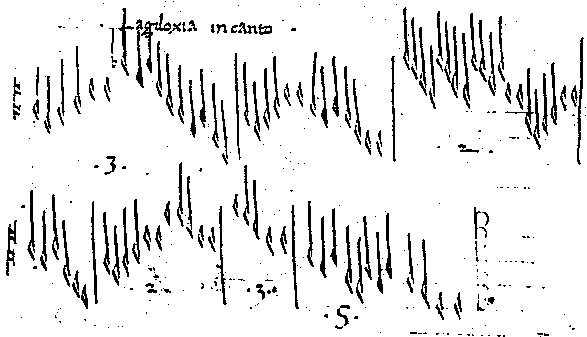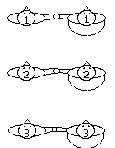
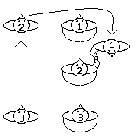
Bar 7 (1st time)
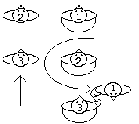
Bar 7 (2nd time)
(Men have all changed places, so Man 2 is in front, Man 3 is in the middle and Man 1 is at the back.)
| Steps: | Sempio (in 4), Saltarello (in 4), Piva (in 4), Contrapasso (in 4), Reverenza, Mezavolta. |  |
| Start: | Three couples, holding hands, facing up the hall, Women on the right. Couple 1 is in front, Couple 2 is three steps behind them, and Couple 3 is three steps behind Couple 2. | |
| [Two-bar introduction on accompanying tape] | ||
| 1-2 (three times) | \ 8 Saltarelli, starting Left |  Bar 7 (1st time) |
| 3-4 | / | |
| 5-6 (1st time) | Man 1 does 3 Contrapassi Left, going in front of Woman 1, to end to the right and ahead of Woman 2, and Reverenza Left (half-bar) to Woman 2, while touching her right hand. | |
| 7 (1st time) | Man 2 Saltarello Right to join Woman 1. | |
| 5-6 (2nd time) | Man 1 does 3 Contrapassi left, going in front of Woman 2, circling counterclockwise most of the way around her, ending to the right of Woman 3, then half-bar Reverenza Left, touching the right hand of Woman 3. |  Bar 7 (2nd time) |
| 7 (2nd time) | Man 3 Saltarello Right to join Woman 2. | |
| 8 | Man 1 Saltarello Right, behind Woman 3, ending at her left. (Men have all changed places, so Man 2 is in front, Man 3 is in the middle and Man 1 is at the back.) | |
| 9-10 (twice) | 8 Pive (each takes half a bar), starting Left, holding hands with new partners. Drop hands. | |
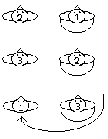 |
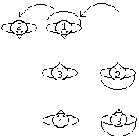 |
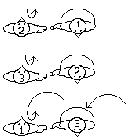 |
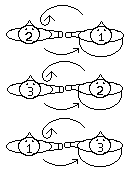 |
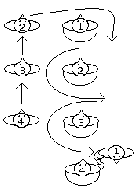 4-Couple Dance | ||
| 11 (1st time) | Couple 1 (i.e. Man 2 and Woman 1) Mezavolta (Piva Left, counterclockwise, taking half a bar), and then pause for the rest of the bar. | |
| 11 (2nd time) | Couple 2 the same. | |
| 11 (3rd time) | Couple 3 Mezavolta (as before). All Men end with a Mezavolta (Piva Right, counterclockwise, taking half a bar). (Men are facing up the hall, Women down.) | |
| 12-14 (1st time) | Sempio Left, Sempio Right, Sempio Left, taking right hands and exchanging places with partner. | |
| 12-14 (2nd time) | Sempio Right, Sempio Left, Sempio Right, taking left hands and going back to place, Men ending with a Mezavolta Right.(Couples are all facing up the hall. Man 2 is now Man 1, Man 3 is Man 2 and Man 1 is Man 3.) | |
| Repeat the dance twice more, until each man returns to his starting place. | ||
| Variations | 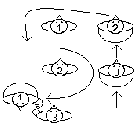 Women Leading Repeat | |
|
To simplify the dance, when it is being taught rapidly to people not familiar with Italian steps, replace the saltarelli with 'doubles', and the contrapassi with 'fast doubles' on alternating feet. Section V can be replaced with each man in turn doing a reverenza to his partner, as she turns to face him. If more than three couples are going to do the dance: Section II is repeated another time for each extra couple. Man 1 will do the same counterclockwise C-shape that he did around Woman 2 around of each extra woman until he gets to the last one. Section V is played as many times as there are couples. The entire dance is played as many times as there are couples, so that Man 1 returns to his place at the end of the dance. Another version, where women lead the second time: repeat the dance only once, with the roles reversed, so the women will change partners. At the end of that repeat, everyone will be back together with their original partners, but Couple 1 will be at the very end and Couple 2 will be at the front. The path Woman 1 takes in Section II will be the mirror-image of the one Man 1 took, but the dance is otherwise identical. | ||
Recordings
Gelosia has a number of different variations in the way the music can be interpreted. Two of the common variations are noted here, with the changes that can be made to the choreography, in order to make the dance work.
Variation A: Instead of Section II being played twice (each having three bars) followed by Section III (one bar), there is a four-bar sequence (Section II and Section III) played twice, resulting in a total of eight bars instead of seven. To use this, have Man 1 do his three contrapassi to Woman 2 in the first two bars, but then do a full reverenza in the third bar, (instead of in a half-bar at the end of the contrapassi). Then Man 2 moves forward in the fourth bar. Man 1 then repeats the three contrapassi, and a full reverenza to Woman 3 in the repeat of the first three bars. Man 3 moves up to join Woman 2, while at the same time Man 1 moves around behind Woman 3 to join her in the repeat of the fourth bar.
Variation B: Section VI is played five times instead of twice, giving fifteen bars instead of six. With this variation, one solution is to circle each way with six sempii instead of three. The last repeat of the music is used for the men's mezavolta (using 2 steps and a pause), instead of it being done on the last beat.
Cour - Recorder introduction followed by a short pause. Fits this reconstruction except with Variation B (see above). Played three times. Ends with about three bars of extra recorder music.
Dances Courts 2 - Drum introduction. Uses Variation A (see above), but otherwise fits this reconstruction. The music is played three times.
Danzare - "Gelosia -1st version, 3 times": No introduction. Works with this reconstruction. Played three times with one long note at the end. (There is another version of Gelosia on this tape which is meant for a five-couple set. It is played sufficiently differently than what our reconstruction calls for that it is not included here.)
Forse - One-bar introduction. Works with this reconstruction, except uses Variation B (see above). Played three times.
Mesura - Four-bar introduction. Works with this reconstruction. Played three times.
Music Leonardo - No introduction. Variation A (see above). Only played twice, so this is a good version to use for the variation where the women lead the repeat.
SCA Dance - One-bar drum introduction. Bars 1-2 are only played once, so Section I is four bars long; use four saltarelli instead of eight. Section VI is played three times instead of twice, so use the last repeat for the men's mezavolta. The dance is played three times, and Section I is played once at the end.
Sonare - Two repeats of Section VI are used for an introduction. Section I is only six bars long, so use six saltarelli instead of eight. Played three times.
Dance Notes
Number of dancers: PnD only says it is for three, but Sc and MOe say it is for six, eight or ten dancers, and NYp ends saying there can be "moltisime chopie" with an instruction that the dance should be repeated until each returns to his woman.
Section I: PnD only says to do six saltarelli largi, but gives eight bars of music. Possibly the saltarelli largi should take more than one bar to perform, but since PnA and PnG both call for eight bars of saltarello with the same amount of music, it is more likely that the saltarelli largi are merely saltarello done more slowly because they are in quadernaria. If six saltarelli are desired instead of eight, drop the third playing of Bars 1-2.
Bars 6-7: In NYp it is clear that the reverenza is done in Bar 6, as Man 2 is instructed to do his doppio (saltarello in the other sources) "in quelo tempo". It is quite probable that the other sources also meant the dance to be performed this way, but we decided to keep the reverenza on the end of Bar 6, in order to use up the half bar that remains at the end of our contrapassi sequence in quadernaria, and to prevent Man 1 and Man 2 moving at the same time, which is a little easier to teach.
Section V: PnD has each couple do a mezavolta with one piva (more specifically, in one tempo of piva), without a foot being given. Left is the obvious choice, as the last piva of the previous section is on the right. Bar 11 is the same length as Bars 9 and 10 in Section IV, where two pive fit in a bar, so only half a bar is used for the mezavolta.
The remainder of the bar does not seem to be used in PnD, except on the third playing, which is followed by an instruction that each man should look at the face of his woman, and the woman at him ("li homini se retrova guardare neL volta ala sua dona e la dona a lui"). Because they are about to take right hands and the women's right hands are already in the center, the men need to turn. We decided to use the second half of Bar 11, on the third playing, for the men to turn with a piva right, although this is not specified in the manuscripts. This leaves them ready to move their left feet next (see also Section VI).
Some of the other sources give the entire section as a voltatonda (performed by each couple sequentially). This resolves what to do with the entire bar, and, if the voltatonda is done with either two pive or four steps, leaves the dancers ready with their left feet free. The voltatonda in that case would not be a precise circle, but would be whatever amount of turn is necessary to leave the dancers ready to take their partners' hands.
This section has considerable variation in the different sources. The simplest version is in NYp, where each man in turn does a reverenza to his partner.
Section VI: PnD says that the sempii start on the right foot, while all the other sources say that the movement (not always sempii) starts on the left. Because the last step that was actually specified in PnD was the mezavolta done with a piva, presumably on the left, it would be consistent to have the sempii start on the right. This would mean, however, that Section VI would end with the dancers ready to start over on the right, while they start the dance on the left. Because of this, and because our reconstruction leaves the men ready to step on the left at the end of Section V, we decided to have the sempii start on the left foot.
This section in particular shows considerable variation among the sources. PnD also has an 'S' or '5' below the music, which is often interpreted as meaning the section is played five times (see music notes below). We decided that there are insufficient steps for that many repeats, and changed it to two repeats.
Repeat: PnD specifies that the dance should be done three times, so we used this pattern here. NYp ends saying there can be "moltisime chopie'"with an instruction that the dance should be repeated until each returns to his woman, so for sets of more than three couples that pattern is followed. Fn and Fl say that the women should lead for the repeat, so we presume that a variation where the dance is only played twice, the woman doing everything first the second time, is another possibility. It may be that for three couples the dance is played six times, so that each man and each women has a turn and the couples all return to their starting place, but we felt this would be excessive.
Music Notes
Gelosia presents two dilemmas: key signature and the number of times to play the final section.

There is no key signature in either PnD or PnG, but in both cases the first F is marked with a flat sign. It would be necessary to either flat the Bs or sharp the Fs to avoid numerous melodic tritones, and we have seen both approaches taken in transcriptions of this piece. In fact, we spent a year or so believing that a transcription with one sharp in the key signature was correct -- the reasoning being "why flatten an F that wasn't sharp?".
However, such a key signature would be unique in this repertoire, and it produced a melody that didn't quite resolve satisfactorily, so we began to look for alternatives. Sparti and A. William Smith both suggest a key signature of one flat; Sparti appears to take the interpretation that the flat sign indicates an F natural throughout the piece (not just for that one note), which would require flatted Bs, while Smith applies the flat to the next note (an E) instead of to the F. We concur that the key signature should probably be that of one flat; this also produces a more satisfactory melody.
The other dilemma concerns the final section of music. In the space below the staff usually used to indicate the number of times to play a part, PnD has an "S". (It is pretty clearly an "S" and not a "5".) PnG does not include any notation for this section. The choreography appears to require twice as much music as is provided, so we have added a repeat marker and ignored the "S".
A literal transcription of the PnD music follows.

The music, as it appears in PnD, follows.
